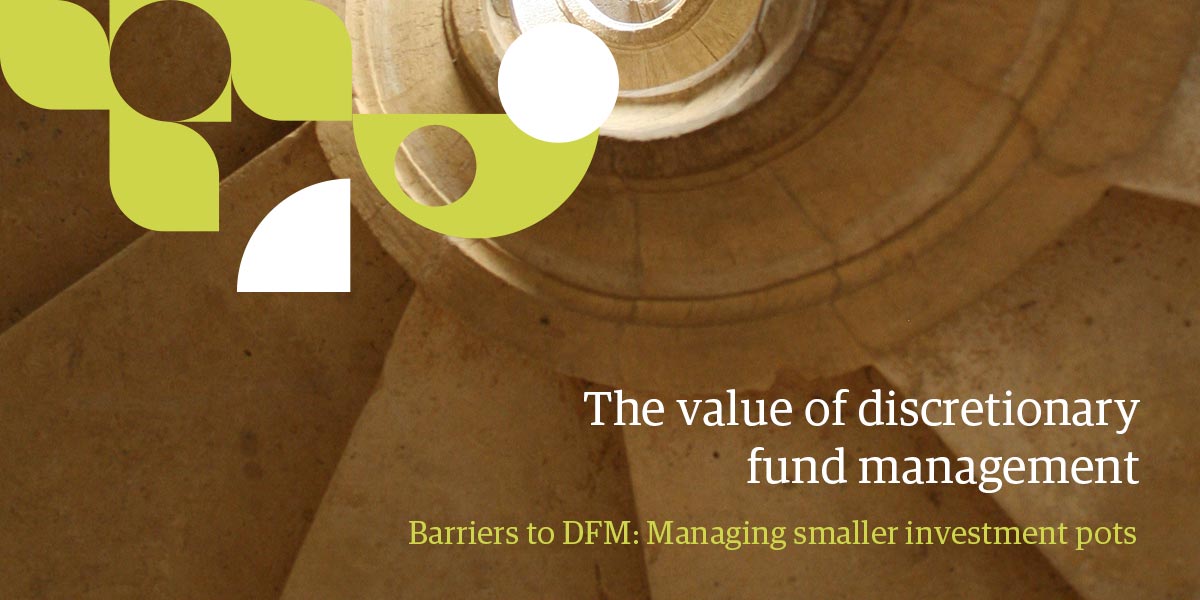Among the main barriers to adopting a DFM cited by financial advisers it is the cost, the potential loss of control and the inability to justify their own fee to clients that crop up as the main issues.

Barriers to DFM: Managing smaller investment pots
While the Rathbones Value of DFM report has been able to pick apart these misconceptions, offering evidence of the positive impact a DFM has on each measure, one major misunderstanding remains.
Many advisers, just under half of those surveyed for the purposes of the report (42%), believed their client base would not be wealthy enough to warrant taking on a DFM.
It was the fourth highest-ranking answer among advisers when asking what the main barrier was to using a third-party investment manager, yet the perception that a DFM is only of any good for clients with pots of £100,000 or more is just another myth that shrouds advisers’ attitude towards DFM.
RDR and the advice gap
The lack of support out there for investors with relatively small investment pots is a widely-acknowledged yet unintended consequence of the Retail Distribution Review (RDR).
The implementation of RDR saw the doors of many advice firms and banks close to people with less than £100,000 to invest. The rules banned firms from taking commissions from the products they recommended and instead made them charge a direct fee for the advice provided.
High street banks, investment management firms and financial advisers all began to withdraw services for people with smaller pots, saying the cost of servicing them was too great.
New entrants have tried to fill the gap, with some robo-advice firms stepping up to provide investment tips and guidance, but it is important that financial advisers do not keep the door closed to new clients simply because they come with a smaller pool of assets.
A DFM service often comes with a whole swathe of products to suit a range of different investment needs, and handing over the management of client investments can mean an adviser is in a far better position to serve smaller customers as well.
A shift in attitude
The Rathbones’ report revealed a stark difference in attitudes between users of DFM and non-users when it came to clients with less than £50,000 to invest.
More than a quarter (27%) of non-users offered their smaller clients the same service as those with larger pots. This stands in clear contrast to advisers with DFM support where only 9% offered the same service to all clients regardless of size.
Users with access to the full range of services a DFM can provide, such as multi-asset or multi-manager solutions, evidently have far more choice when it comes to servicing a client with less than £50,000.
A DFM service also comes with its own advantages. Accessing funds via an MPS solution managed in-house, for example, can benefit the end-client by avoiding the barriers thrown up if they tried to invest via a platform. In-house management can avoid the tax charges and trading restrictions of a platform, as well as the collective and platform charges and management fees, while offering a hedging facility too.
Ultimately, those advisers with the support of an external investment manager are more willing and able to accept clients with smaller investment pots in the knowledge they have the tools to service them properly. This increases client numbers and in turn, revenue.
By the same token users are in a far better position to turn away clients with smaller investment pots if they do not benefit their business model. 16% of users said they would turn away new clients with less to invest as compared to 12% of non-users who said the same.
Once again, the misconceptions surrounding DFM use that hold advisers back from adopting the structure clear once the real impact of adoption is examined, something that has only been possible with the startling results of the comprehensive Value of DFM survey and report.
Download the second chapter of our DFM research report - The value of discretionary fund management.

